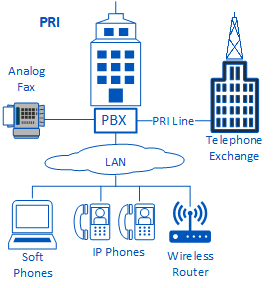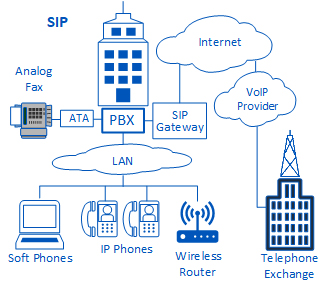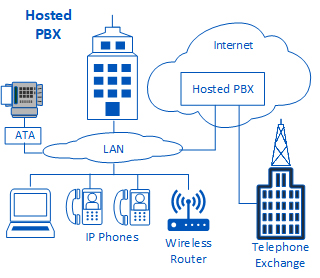PRI, SIP, or Hosted PBX, Which One is Right for You?
Choosing between PRI, SIP-Trunks, and Hosted PBX solutions for your unified communications needs depends on a variety of factors, including the size of your organization, your budget, the features you require, and your communication objectives. Here’s a chart to help you evaluate the pros and cons of each option to help you choose the one that’s best for your organization.
Description
Primary Rate Interface - PRI
Session Initiated Protocol - SIP
Hosted PBX
PRI provides on-premises PBXs with digital, end-to-end connections for multiple, simultaneous voice, data, or video transmissions through a physical line, a.k.a. circuit to the PSTN.
SIP provides on-premises PBXs with a virtual link to the PSTN via the internet. SIP offers digital, end-to-end connections for multiple, simultaneous voice, data, or video transmissions.
Hosted PBX is a cloud-based phone system solution managed and maintained by a third-party service provider and provisioned via the Internet.
Design
Primary Rate Interface - PRI
Session Initiated Protocol - SIP
Hosted PBX



Requirements
Primary Rate Interface - PRI
Session Initiated Protocol - SIP
Hosted PBX
Each PRI physical circuit requires a cable containing two pairs of copper wires. It provides 23 channels for 23 concurrent conversations, chats, or videos. Additional PRI circuits are required for more than 23 concurrent transmissions.
Requires installing a SIP-enabled server and gateways; however, no additional cables, wires, or other equipment is needed.
Each communication channel in SIP is called a trunk (a.k.a. SIP trunking). The number of SIP trunking is limited only by available bandwidth.
Resides in the cloud, so no on-premises PBX equipment is required. The hosting service provider is responsible for monitoring, upgrading, and patching the system.
Advantages
Primary Rate Interface - PRI
Session Initiated Protocol - SIP
Hosted PBX
- Well-established standard, widely used for over 40 years, makes PRI phone systems generally more reliable and low risk
- Does not rely on IP connectivity and is not sensitive to shared bandwidth issues or internet outages
- Offers support for legacy analog technologies such as fax machines
- PRI calls are not exposed to internet security risks; however, PRI calls are subject to other security risks, including call interception and interference
- Uses data networks instead of telephone technology, so SIP works seamlessly with existing IP phones, desktop computers, and mobile devices
- More scalable than PRI-based systems. In many cases, new channels can be added without additional hardware
- Easily add new features and integrate with advanced collaboration solutions
- When channels go down, calls can easily be rerouted with little impact on users
- Higher initial costs than hosted can be offset by lower licensing and user costs
- No upfront hardware costs, even the phones can be rented – Just a monthly subscription for service, maintenance, features, upgrades and support
- Scaling up requires no additional hardware; you simply contact your service provider
- Systems are always up to date with the latest and greatest software
- No technical staff is required to manage, maintain, and upgrade systems and components
Limitations
Primary Rate Interface - PRI
Session Initiated Protocol - SIP
Hosted PBX
- Monthly service for long-distance and international calls is likely to exceed IP-based systems
- Scaling up and adding new lines is costlier than IP-based systems.
- Can only be scaled up in units of 23 lines
- Additional lines can be added to help with redundancy. However, calls cannot be rerouted if your PRI system goes down
- The increased popularity of cloud-based phone systems makes PRI technicians, hardware, and support increasingly rare
- Interoperability with internet collaboration solutions is limited
- Reliability and call quality rely on internet availability and bandwidth
- Increased security and compliance challenges
- Requires analog telephone adapters (ATAs) for dedicated analog endpoints, such as fax machines, service elevator lines, fire panels, etc.
- More upfront costs than Hosted PBX solutions
- Requires staff to manage, maintain, and upgrade on-premises systems
- Less control than on-premises systems – if anything goes wrong, you are at the mercy of the provider.
- May require minimal upfront hardware and infrastructure costs for private WAN links.
- May be more expensive over time; however, lower maintenance and administrative costs may offset subscription costs
Recommended For
Primary Rate Interface - PRI
Session Initiated Protocol - SIP
Hosted PBX
- Organizations with existing an on-premises PBX that is working fine and don’t foresee the need for additional lines, now or in the near future
- Organizations expecting high call volumes that require exceptional voice quality
- Organizations with a significant number of analog devices
- Organizations with little or no access to a reliable fiber-optic network or limited access to the internet
- Organizations lacking sufficient bandwidth to support IP phones and equipment
- Organizations with the network infrastructure and bandwidth to support SIP traffic
- Organizations that prefer long-term capital expenses and lower operating expenses
- Organizations that make a lot of long-distance and international calls and you are looking to cut costs
- Organizations needing the flexibility and scalability to accommodate future growth with the security and reliability of an on-premises solution
- Organizations with contact centers providing multi-channel communications
- Organizations with a distributed workforce and remote workers
- Organizations starting from scratch that are ready to replace their entire communications system or are expanding rapidly
- Small businesses and start-up companies with less than 50 employees
- Organizations looking to reduce the workload of onsite IT staff
- Organizations desiring the flexibility to add new features, and the ability to scale up (or back) quickly and efficiently
It can be difficult determining which path is right for your organization. A knowledgeable partner can help. Cerium Networks UC experts have the expertise and insight to help you evaluate, design, implement, manage and secure your business communications. Contact Cerium to learn more about strategies for optimizing and future-proofing your UC environment.





